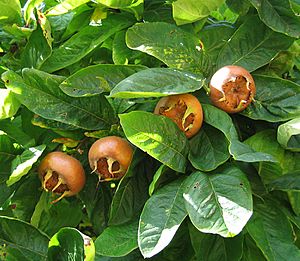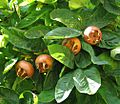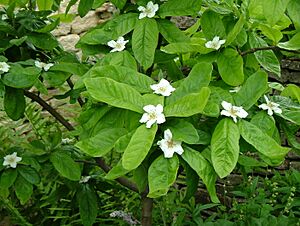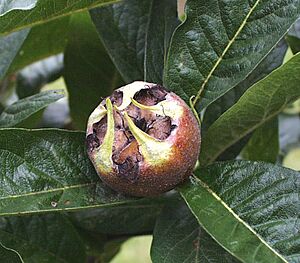Mespilus facts for kids
Quick facts for kids Mespilus |
|
|---|---|
 |
|
| Common medlar foliage and fruit | |
| Scientific classification |
|
| Kingdom: | Plantae |
| Clade: | Tracheophytes |
| Clade: | Angiosperms |
| Clade: | Eudicots |
| Clade: | Rosids |
| Order: | Rosales |
| Family: | Rosaceae |
| Subfamily: | Amygdaloideae |
| Tribe: | Maleae |
| Subtribe: | Malinae |
| Genus: | Mespilus Bosc ex Spach |
| Species | |
The medlar (scientific name: Mespilus) is a unique flowering plant. It belongs to the Rosaceae family, which also includes roses and apples! There's only one main type of medlar, called Mespilus germanica. This plant originally comes from southwest Asia. You can also find it in some parts of southeastern Europe, like the Balkans. Another plant, Mespilus canescens, was once thought to be a medlar. But scientists later found out it's actually a mix of the common medlar and a hawthorn plant.
Contents
What is a Medlar Plant?
Medlar plants can grow as large shrubs or small trees. They can reach up to about 26 feet (8 meters) tall. Like many trees, medlars are deciduous. This means their leaves fall off in the autumn. The fruit of the medlar is a dull brown and looks a bit like a small apple.
History of the Medlar Fruit
The Mespilus germanica plant is originally from southwest Asia and southeastern Europe. This includes areas near the Black Sea and the western Mediterranean. People started growing medlars a very long time ago. The ancient Greeks and Romans were growing them as early as the second century BC.
Medlars were a very popular fruit in Western Europe during the Middle Ages. However, they are not as common today.
Different Types of Medlar Plants
Here are some plants that are considered medlars or were once thought to be:
| Image | Scientific Name | Common Name | Where it Grows |
|---|---|---|---|
 |
Mespilus canescens | Stern's Medlar | Prairie County, Arkansas, United States |
 |
Mespilus germanica | Common Medlar | Southwest Asia and southeastern Europe |
Plants Related to Medlars
The medlar plant is closely related to several other plants in the same family. These include Crataegus (hawthorns), Amelanchier (serviceberry), and Peraphyllum.
The loquat fruit, which comes from the Eriobotrya genus, was once thought to be very similar to the medlar. In some European countries, the loquat is still sometimes called the "Japanese medlar."
Some scientists even group the medlar plant with hawthorns. If they are combined, the medlar's scientific name would change to Crataegus germanica.
You might also hear the name "snowy mespilus." This name is used for some types of Amelanchier plants, like Amelanchier lamarckii.
The Medlar Fruit
The fruit of the Mespilus germanica is quite unique. It looks a bit like a small, brown apple. In warmer places, like southern Europe, medlar fruits can ripen fully on the tree. You can eat them right away!
However, in cooler places, like northern climates, the fruit needs a special process called bletting. This means you pick the fruit when it's hard. Then, you let it ripen off the tree, usually in a bowl, until it becomes very soft. Only then is it ready to eat.
Each medlar fruit has about six hard, oddly shaped seeds inside. These seeds need to go through a cold period to sprout. Many different types of medlar plants exist today. They are becoming more popular in North America for gardens and edible landscapes.
See also
 In Spanish: Mespilus para niños
In Spanish: Mespilus para niños



